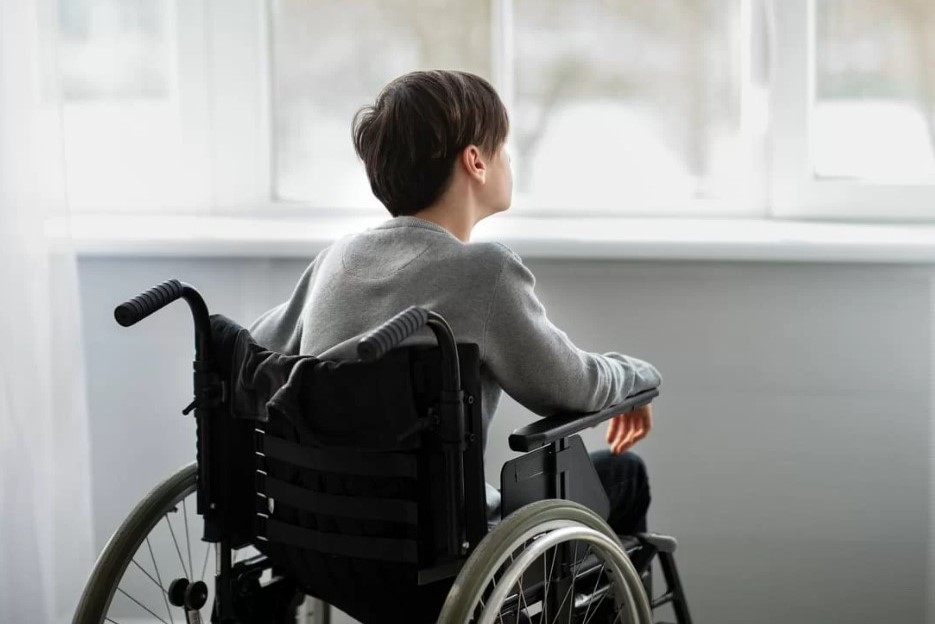
What is Duchenne muscular dystrophy?
Duchenne muscular dystrophy is a rare hereditary disease that progressively subverts the structure of muscle
The muscles of patients with this disease show degenerative aspects that gradually lead to the loss of normal motor functions.
Which muscles Duchenne muscular dystrophy affects
Duchenne muscular dystrophy affects muscles and leads to substantial degenerative processes that are insufficiently balanced by regenerative processes.
The structure of the muscle tissue is subverted and a large part of it, instead of being made up of muscle fibres, turns into connective and fibrotic tissue, losing its contractile capacity.
The disease leads to severe muscle weakness and atrophy, involving the main muscles of the affected patient’s body.
It affects mainly and in order
- the large muscles of the arms and legs;
- the proximal muscles (those closest to the centre of the body);
- the distal muscles (those farthest from the centre of the body);
- the respiratory muscles;
- the intercostal muscles;
- the diaphragm;
- heart.
It never involves the facial muscles, nor the deglutition muscles.
The incidence of Duchenne muscular dystrophy
Duchenne disease is a paediatric, neuromuscular, hereditary X-linked, i.e. X-linked chromosome disease, and affects male subjects.
The disease is found in almost all cases in males.
This is because the protein that causes Duchenne dystrophy, dystrophin, is encoded by a gene that is present on the X chromosome.
The numbers of Duchenne dystrophy can be translated into:
- 1 in 3,500 male births, the classic incidence, which according to the latest estimates has risen to 1 in every 5,000 male births;
- 3.5 years, the average age at which the disease is diagnosed in Italy (in Europe the average diagnosis is made at around 4.5 years).
The symptoms of Duchenne muscular dystrophy
Duchenne muscular dystrophy has always been considered a paediatric disease: its onset occurs in the first decade, although it has been present since birth, with rapid degeneration in youth and premature death.
The main warning to recognise this type of disease is Gowers’ sign in the change of position: a typical movement in which the child tries to get up from a supine position by leaning on surrounding supports or by levering his or her legs with his or her arms.
In general, other signs in affected children may be:
- delayed onset of walking compared to the average;
- tendency to stumble, awkward walking or difficulty in walking, attitudes that may suggest a ‘lazy’ child;
- more rarely, a mild cognitive disorder or an autism spectrum disorder.
When a child begins to show some of these alarm bells, it is useful to consult a neurological specialist, so that a clinical procedure can be undertaken to arrive at a definite diagnosis.
RARE DISEASES, VISIT THE UNIAMO BOOTH AT EMERGENCY EXPO
Diagnosis
To date, specialists can make use of tests such as:
- dosage of the enzyme CK (Creatine Kinase): ‘Normal values are below 200 U/L; in affected individuals, values exceed the order of thousands’;
- genetic examination, resulting from the objective examination and the altered CK values, with results in approximately 1-2 months.
Therapy for Duchenne muscular syndrome
For Duchenne’s disease we do not yet have a therapy that can solve the problem.
In earlier times, affected children quickly lost the ability to walk and the degeneration passed to the other muscles just as quickly.
The introduction of a multidisciplinary approach to the patient since the 1980s has, however, led to an improvement in the life and survival expectancy of affected patients.
Although there is no effective therapy, simply taking corticosteroid therapy allows the disease to improve in all areas:
- ability to walk lasts on average 2 years longer than the disease average;
- improvement in respiratory functions;
- improvement in cardiac capacity.
Treatment, a research bet
In addition to this supportive therapy, researchers are working to find new therapies that can change the course of the disease.
This is one of the fields of investment we have been experiencing in recent years.
The studies carried out so far have not yet yielded satisfactory results, but we have numerous clinical trials underway and planned for this type of disease: we hope that some of these studies will give us positive results in the next 3-5 years.
Next year, new therapy studies will start at our centre, in collaboration with other institutes in Europe and the US, including a new generation of synthetic oligonucleotides to restore the synthesis of the missing, smaller, but functioning dystrophin protein.
Research is making progress, getting closer to a solution for this disease: hope is high: we are in an era where therapies are on the way.
Read Also:
Emergency Live Even More…Live: Download The New Free App Of Your Newspaper For IOS And Android
Today Is World Duchenne Muscular Dystrophy Awareness Day
When Dementia Affects Children: Sanfilippo Syndrome
Zika Linked To Guillain-Barre Syndrome In New Study
Down Syndrome And COVID-19, Research At Yale University
Rescue Training, Neuroleptic Malignant Syndrome: What It Is And How To Deal With It
Guillain-Barré Syndrome, Neurologist: ‘No Link To Covid Or Vaccine’
Facial Nerve Injuries: Bell’s Palsy And Other Causes Of Paralysis
Rare Diseases: Russian Economist Anatoly Chubais Diagnosed With Guillain Barré Syndrome
Ultrarare Diseases: First Guidelines For Malan Syndrome Published



